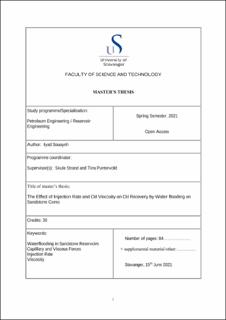| dc.description.abstract | With every passing day, the rise for developing and optimizing oil recovery methods and techniques grows, since the global demand for energy is increasing exponentially. Water flooding is still regarded as the most widely used recovery method due to its easy accessibility and applicability. Water flooding is usually performed by injecting the produced formation water of the reservoir back into the reservoir to displace oil and maintain pressure. For the case of offshore, sea water is used.
There had been laboratory studies on how to improve the effectiveness of water flooding to achieve higher oil recovery. It is important to understand and investigate the role of the displacement forces, mainly viscous and capillary forces. Some researches highlighted the significance of injection velocity and viscosity of oil in analyzing the efficiency of water flooding in recovering oil.
The objective of this thesis was to investigate the effect of injection rate and oil viscosity on the oil recovery from two water-wet sandstone core samples by water flooding. Two outcrop cores were used: Bandera Brown and Leopard. Several core flood experiments were performed on each core using a modified non-polar mineral oil to prevent alteration of the initial wetting conditions of the samples. The core was restored to initial conditions by mild cleaning using heptane and low salinity brine. The modified mineral oil was made by mixing marcol and heptane in different ratios by volume, causing a variation in the viscosity when the mixing ratios were changed. The oil recovery and pressure drop when changing the injection rate, followed by changing the viscosity, were presented, and compared to evaluate the effect of viscous and/or capillary forces.
The results showed that there was minimal effect of changing injection rate for Bandera Brown core, since both oil recoveries from high and low rates were the same. This was not the case for the Leopard core, as lower injection rate yielded lower oil recovery. However, a possibility of formation damage arose because the pressure drop has not changed when the injection rate was lowered. Moreover, fine grains were found in effluent when the core was flooded with low salinity during core cleaning, signifying a low consolidation of the core. As for viscosity of oil effect, the oil recovery using a lower viscous oil was lower, which is an unusual observation. Though there were abnormal continuous abnormal pressure drop build up, and since there were issues encountered with the Leopard core at previous restorations. There were no conclusive remarks for effect of oil viscosity on water flooding for Bandera Brown core, due to two failed experiment attempts. The first attempt led to breaking the core causing a reduction in length and porosity. The second attempt resulted in achieving very low oil recovery (12%), after the core was exposed to distilled water before the start of the experiment when the rubber sleeve got punctured by the confining pressure.
Based on the results of the experiments on the Bandera Brown core, the possibility of the importance of capillary forces in oil recovery in water-wet system can be seen. This is caused by the imbibition of the wetting phase (formation water) into small pores of the core. | |
